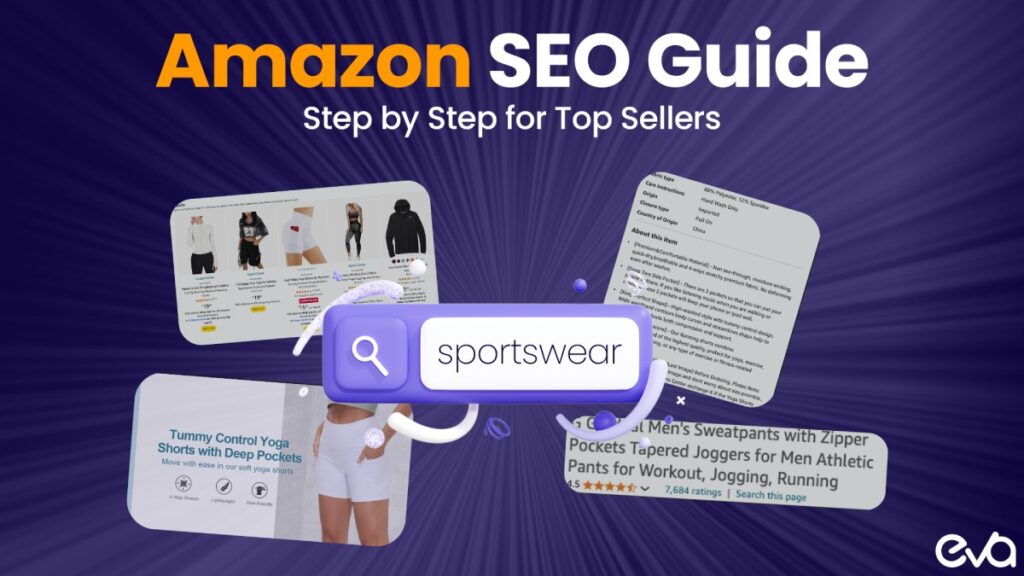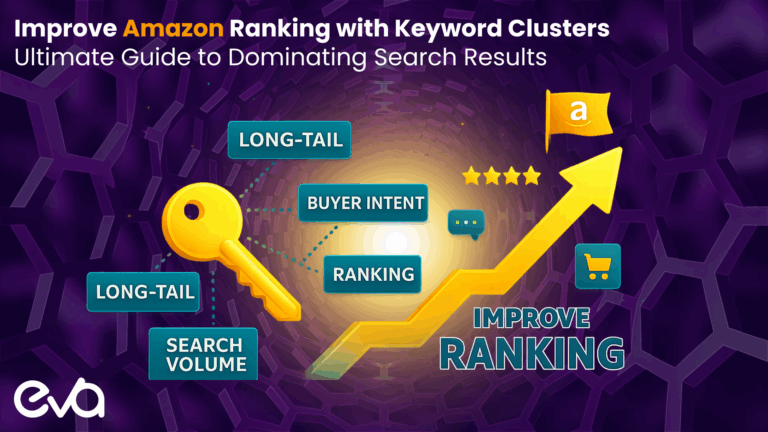Amazon sellers often don’t understand why their items stay on page 10 while rivals’ items that aren’t as good get to page 1. The answer isn’t luck or spending a lot of money on ads; it’s Amazon SEO.
More than 80% of purchases come from the first 10 search results. This means that being higher on the list directly leads to more sales. You can follow this step-by-step guide to improve your listings, from choosing the right keywords to getting more reviews.
By the end, you’ll know all the strategies that will work in 2025 and have a clear plan for how to bring them to life right now.
Table of Contents
- What Is Amazon SEO and How Does It Work?
- How Much Difference Does Amazon SEO Make to Your Sales?
- How Does Amazon Decide Which Products to Show First?
- How to Find the Right Amazon SEO Keywords?
- How To Write Amazon SEO Product Titles That Get Clicked?
- Amazon SEO For Your Product Bullet Points
- Amazon SEO Guide To Optimize Product Images
- How To Write Amazon SEO Backend Keywords?
- How Should You Price Your Product For Amazon SEO?
- Amazon Ads to Boost Your Amazon SEO Rankings
- How Can Traffic From Other Websites Help Your Amazon SEO?
- What Numbers Should You Track For Your Amazon SEO?
- Free vs Paid Amazon SEO Tools That You Really Need
- FAQs
What Is Amazon SEO and How Does It Work?
Amazon SEO is the process of getting your product to show up when people search on Amazon. That’s it.
When someone searches for “wireless headphones” on Amazon, the site chooses which items to show first. So, if your product is on the first page, people will buy it, but no one will ever find it if it’s hidden on page 30.
This is what makes Amazon different from Google. People who use Google might just want to find out something; however, people on Amazon want to buy something. They’ve made up their minds to spend money, and they are only looking for the best choice.
In fact, you don’t have to sell to people and only need to be there when they’re ready to buy.
Amazon SEO has three main parts:
- Keywords: Using search terms that people actually type
- Optimization: Making your product description look good and easy to read
- Performance: Getting people to buy your product when they click on it
Amazon will show your product to more people if you do these three things right. And the best part is, if your page ranks well, people will keep coming to it without having to pay for ads.
How Much Difference Does Amazon SEO Make to Your Sales?
The difference is huge. We’re talking about the gap between making money and losing money.
Position matters more than you think:
- Position #1 gets 30% of all clicks
- Position #5 gets 8% of clicks
- Position #10 gets 2% of clicks
- Page 2 gets almost nothing
A product ranking #1 for “wireless mouse” might get 2,000 clicks per month, and the same product ranking #15 might get 50 clicks per month.
Do you get it? That’s 40 times fewer potential customers seeing your product.
And revenue impact looks like this:
- Poor SEO: 200 visitors, 4% buy = 8 sales at $25 = $200/month
- Good SEO: 1,500 visitors, 10% buy = 150 sales at $25 = $3,750/month
Same product. Same price. Different SEO results.
Timeline for seeing results:
- Week 1-2: You’ll see small ranking improvements
- Week 3-4: More people start finding your product
- Month 2-3: Sales increase becomes obvious
- Month 4+: Rankings stabilize at higher levels
Most new buyers see their business double in 30 days if they do basic SEO. And within 60 days, sales normally go up by 200 to 300 percent.
How Does Amazon Decide Which Products to Show First?
Amazon uses something called Amazon’s A10 algorithm to choose which items to show up first. This A10 algorithm in Amazon chooses the items that you’ll see when you look for something.
So, how does Amazon’s A10 algorithm work? Anytime someone searches for “phone case,” A10 ranks the thousands of phone cases that come up, and it takes less than a second to happen.
Remember that A10 wants results to stay the same every month. It’s not good enough to sell 100 units one week and then none for three weeks.
There’s also another change. A10 now cares if people find your product somewhere other than Amazon. For example, your ranking goes up if someone buys your products after clicking on a link on Google or Facebook.
Just two things matter to Amazon’s A10 algorithm:
- Relevance: Is your product related to what people typed?
- Performance: Will people buy what you’re selling?
There you have it. That’s all that matters.
Relevance
Anytime someone looks for “yoga mat,” Amazon makes sure that you are selling a yoga mat. It gets this information from your title, bullet points, and text.
A good case of relevance is:
- Search: “bluetooth headphones”
- Your title: “Bluetooth Headphones – Wireless Earbuds with Noise Cancelling”
Bad relevance example:
- Search: “bluetooth headphones”
- Your title: “Premium Audio Device – High Quality Sound Equipment”
Even though both items are headphones, the first tag has the exact words people were looking for. As a result, Amazon makes it easy to link the search to your products.
Performance
Amazon keeps an eye on everything on your page. How many times do they click it? How many people buy it? How many of them send it back? How quickly is your shipping?
This is what good success looks like:
- 1,000 people see your product
- 100 clicks on it (10% click rate)
- 15 buy it (15% conversion rate)
Weak performance looks like this:
- 1,000 people see your product
- 30 click on it (3% click rate)
- 2 buy it (7% conversion rate)
Amazon pushes products with strong numbers higher up, and products with weak numbers get pushed down.
You Need Both Relevance and Performance
It’s not enough to have just one. If your performance is good but your relevance is bad, people will find you but not buy from you. On the other hand, if your relevance is good but your performance is bad, no one will find you.
You want things that match what people are looking for AND make sales from those people who visit your site.
For better relevance:
- Include the exact words people are looking for in your title: Don’t write “cordless computer gadget” when people look for “wireless mouse.”
- Add terms that go with your bullet points: Use phrases like “computer mouse,” “wireless computer mouse,” and “Bluetooth mouse.”
- Choose the correct type of product: Don’t put your portable mouse in Office Products; put it in Electronics > Computers.
- Include different term forms: A lot of people look for both “wireless” and “cordless,” so use both.
For better performance:
- Write clear explanations of your products: Answer questions like “How long does the battery last?” and “Does it work with Macs?”
- Use pictures of good quality: Display your mouse from the top, bottom, side, and next to a hand to get a sense of its size.
- Offer low prices: If portable mice like yours cost $25 to $35, don’t charge $50 for it unless it has special benefits.
- Send quickly: You can use FBA or ship yourself within one to two days.
- Answer quickly when customers ask: Respond within 24 hours, but no more than a few hours is better.
How to Find the Right Amazon SEO Keywords?
Keywords are the words people type when they search on Amazon. So customers will find your products if you use the right phrases.
Nobody will see what you’re selling, though, if you choose the wrong keywords.
Keyword research tools comparison:
| Tool | Time Needed | Cost | Difficulty | Quality | Best For |
| Amazon Autocomplete | 30 minutes | Free | Easy | Good | Starting research |
| Competitor Analysis | 1 hour | Free | Medium | Excellent | Finding proven keywords |
| Customer Reviews | 45 minutes | Free | Easy | Very Good | Natural language |
| Amazon Search Terms Report | 20 minutes | Free | Easy | Excellent | Current customers |
First, look at Amazon’s search bar. It shows you how real customers really use the site. Then, after slowly typing in your main product, look at the ideas that come up.
1- Use Amazon’s Tool for Autocomplete
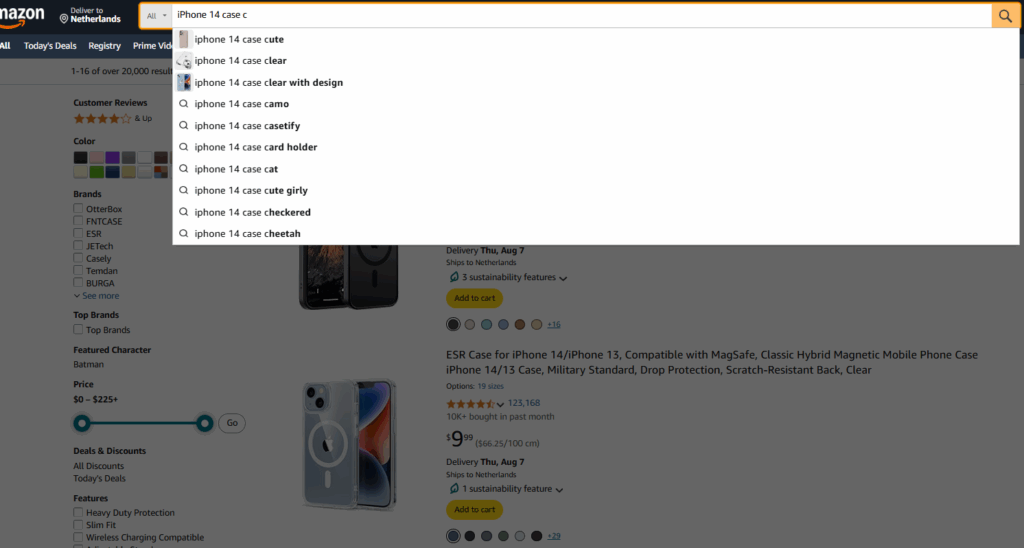
- Go to Amazon.com and type “bluetooth speaker” one letter at a time
- Amazon will show ideas like “Bluetooth speaker small” and “Bluetooth speaker waterproof.”
- Make a note of every idea you come across, even the weird ones.
- After that, try “wireless speaker,” “portable speaker,” and “tiny speaker” as different ways to start.
For “phone case c,” you might discover “phone case clear” or “phone case cute.”
Amazon only shows suggestions for searches that people actually do, so this way works. As a result, you can view live search results for free.
2- Analyze Competitor Listings and Titles
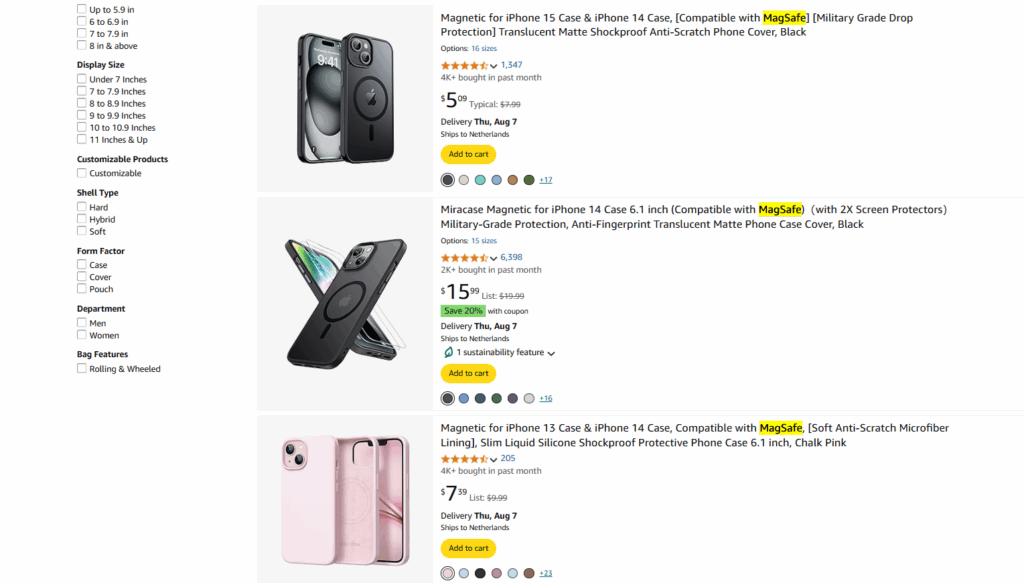
- Pick 5 successful competitors in your category
- Copy their titles and bullet points into a document
- Count which keywords appear most frequently
- Make a list of keywords that multiple competitors use
- Focus on proven keywords that already generate sales
When three competitors use “MagSafe” in their titles, that’s a strong keyword. However, when only one uses “anti-fingerprint,” it’s probably less effective.
3- Read What Other Customers Have Said
Reviews show you what real people say about a product, and the words they use are not what you might think.
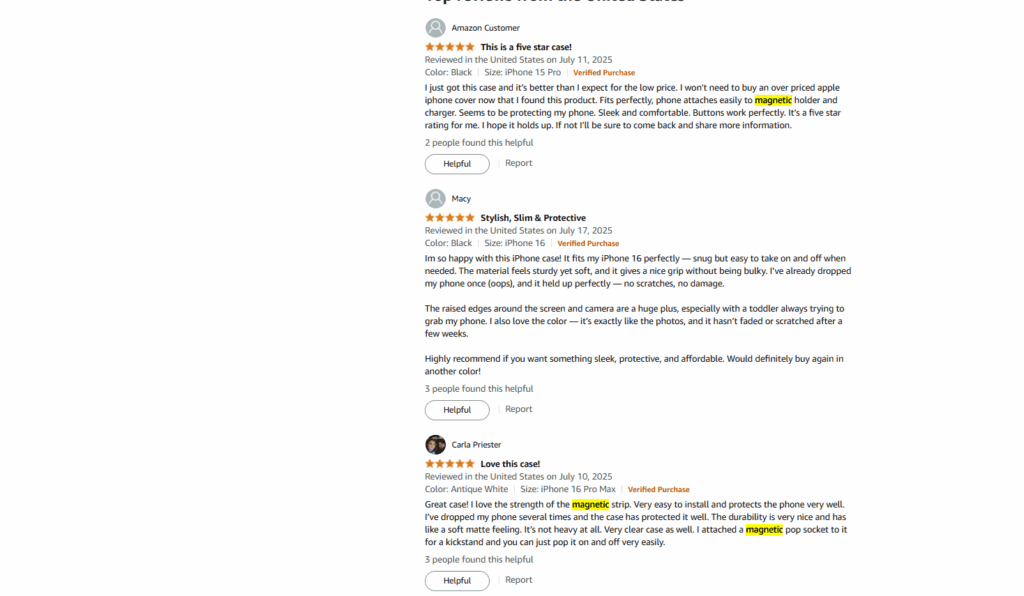
Look at customer reviews to see what keywords they usually use. If someone writes, “This case saves my phone from drops,” that tells you that buyers care about “drop protection.”
Do not ignore the bad reviews either. “Durable material” is a good term to use when people worry about “flimsy material.”
So, browse through 20 to 30 reviews of products that are similar. Then pay attention to the words that people use a lot.
Write down the exact words and sentences that people say. Most of the time, these natural sentences will turn out to be your best Amazon SEO keywords.
How To Organize Your Amazon SEO Keywords
Sort your keywords into three clear groups.
- Main keywords: the 3 to 5 most important words that best describe your product
- Secondary keywords: Similar words that some customers use to look for
- Long-tail keywords: Longer words that not many people look for but get more sales
For a phone case, your organization might look like:
- Main: “iPhone 14 case,” “phone case,” “protective case”
- Secondary: “clear case,” “drop protection,” “wireless charging compatible”
- Long-tail: “iPhone 14 case with screen protector,” “clear phone case drop protection”
How To Write Amazon SEO Product Titles That Get Clicked?
Your title comes up first when someone looks on Amazon, and they click on it if it looks appealing. If it doesn’t, they go on.
What goes in every title:
- Brand name: Put this first so people know who made it
- Product type: Tell them what you’re selling
- Main features: Add the important details people care about
- Size or colour: Include these when they matter
- Material: Add this when it affects the buying choice
Here’s what this looks like: “YETI Rambler 20 oz Stainless Steel Vacuum Insulated Tumbler with MagSlider Lid”
This title has brand (YETI), product (tumbler), features (vacuum insulated), size (20 oz), and material (stainless steel).
Character limits that matter for Amazon SEO product titles:
| View Type | Characters Shown | What This Means |
| Mobile search | 50-60 characters | Most important info goes here |
| Desktop search | 80-100 characters | More space, but still limited |
| Amazon limit | 200 characters total | Don’t use all of this |
| Product page | Full title shows | All 200 characters are visible |
Put your most important words in the first 60 characters since it is what people see on their phones.
Also, don’t waste space on words like “best” or “premium.” They don’t help customers find you and just take up valuable space.
How To Distinguish Your Amazon SEO Title?
It’s important that your title works for both Amazon and real people. That means using the right themes in a way that makes sense to people.
Common mistakes in writing an Amazon SEO title:
| Mistake | Why It’s Bad | What To Do Instead |
| Keyword stuffing | Makes titles hard to read | Use keywords naturally |
| Special symbols | Violates Amazon rules | Stick to letters and numbers |
| Vague words | Doesn’t tell customers anything | Be specific about features |
| ALL CAPS | Looks unprofessional | Use normal capitalization |
| Missing details | Confuses buyers | Include size, colour, key features |
Before and after Amazon SEO title examples:
- Bad Amazon SEO title: “★PREMIUM★ Best Quality Kitchen Gadgets Tools Device Professional Grade Equipment”
- Good Amazon SEO title: “Kitchen Knife Set – 15-Piece Stainless Steel Knives with Wooden Block and Sharpener”
The good Amazon SEO title tells customers exactly what they get, but the bad one uses meaningless words that don’t help anyone.
How To Test Different Amazon SEO Titles?
Amazon lets you test different titles to see which one performs better. This is called A/B testing.
- Keep your current title running while you test a new one
- Change only one element at a time (like moving keywords or adding features)
- Let the test run for at least 2-3 weeks to get reliable data
- Use the title that gets more clicks and sales
Test different keyword positions first and try putting your secondary keyword at the beginning instead of your main keyword. Sometimes this works better for specific products.
Amazon SEO Title Mobile Optimization Tips
Most Amazon shoppers use their phones. Therefore, your title needs to work on small screens.
- Bad mobile title: “Professional Grade Premium Quality Kitchen Appliance Set – Stainless Steel Multi-Function Food Processor with 12 Attachments”
- Good mobile title: “Food Processor – 12 Attachments – Stainless Steel Kitchen Set”
Amazon SEO For Your Product Bullet Points
Bullet points sell your product. They’re where customers decide if they want to buy or not.
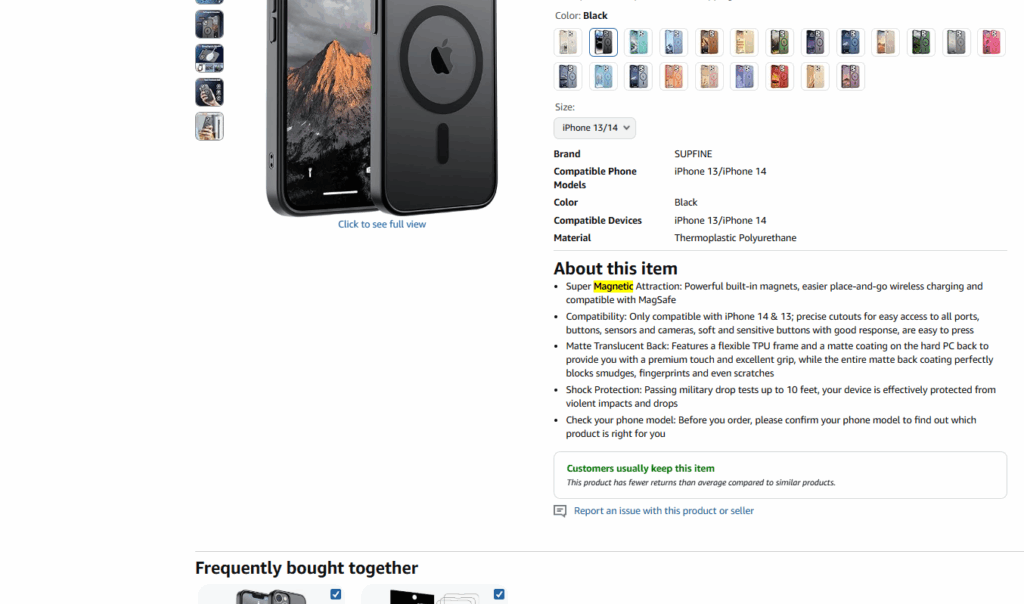
In fact, your title gets people to click, but your bullets convince them to purchase.
How to Structure Amazon SEO Bullet Points That Sell?
Start each bullet point with what the customer gets, not what your product has. People care about benefits, not features.
Benefits vs. Features in Amazon SEO Bullet Points
- Feature: “Made with stainless steel”
- Benefit: “Stays rust-free for years of daily use”
- Feature: “Has 12-hour battery life”
- Benefit: “Listen to music all day without charging.”
- Feature: “Waterproof IPX7 rating”
- Benefit: “Use safely in rain, shower, or pool.”
Features tell customers what your product is. But benefits tell them how it improves their life.
Use All Five Amazon SEO Bullet Points
Amazon gives you five bullets. Use every single one because each bullet is a chance to address different customer concerns.
Here’s how to organize them:
| Bullet Position | What To Include | Example |
| Bullet 1 | Main benefit/problem solved | “Eliminates back pain during long work days.” |
| Bullet 2 | Key feature with benefit | “Memory foam adjusts to your body shape.” |
| Bullet 3 | Usage scenarios | “Perfect for office, car, or home use” |
| Bullet 4 | What’s included/guaranteed | “Includes cover and 30-day money back guarantee” |
| Bullet 5 | Additional benefits/peace of mind | “Easy to clean and maintain” |
Mobile Amazon SEO Bullet Point Format
Most people read bullets on their phones. So keep this in mind when you write.
- Start with the most important word in each bullet: “Waterproof design keeps electronics safe” instead of “This product features waterproof design”
- Keep bullets under 200 characters when possible: About 2-3 lines on mobile
- Use simple words that are easy to read quickly: “fast” instead of “expeditious”
- Break up long sentences into shorter ones: “Easy setup. Works in 5 minutes” instead of “Easy setup process that only takes 5 minutes to complete”
- Put keywords naturally throughout: Include “wireless earbuds” if that’s what people search for
Don’t write paragraphs in your bullets and just keep them focused on one main point each.
What Information Do Customers Need in Amazon SEO Bullet Points?
Customers have questions before they buy. Answer these questions in your bullets, and they’ll feel confident purchasing.
Common customer concerns:
- How big is it? “Measures 12 x 8 x 3 inches – fits on most desks”
- How long does it last? “Battery runs for 48 hours of continuous use.”
- What’s included in the box? “Includes charger, carrying case, and quick start guide.”
- How do I use it? “Press power button once to turn on, twice to change modes”
- What if there’s a problem? “Free replacement within 2 years, no questions asked”
- How much does it weigh? “Weighs only 1.2 pounds – lighter than most laptops”
- Will it work with my device? “Compatible with iPhone 12, 13, 14, and 15”
- How fast does it work? “Charges your phone from 0% to 80% in 30 minutes”
Address these concerns directly in your bullets and don’t make customers guess.
1- Make Scenarios in Your Amazon SEO Bullet Points
Tell customers exactly when and where to use your product.
- Instead of: “Great for fitness”
- Write: “Perfect for gym workouts, home exercises, and outdoor running”
Amazon SEO bullet point example for a water bottle:
- “Stays cold for 24 hours during long work days.”
- “Fits in car cup holders and backpack side pockets.”
- “Perfect size for gym, office, or hiking trips”
Amazon SEO bullet point example for a phone case:
- “Protects your phone during daily commutes.”
- “Wireless charging works through the case.”
- “Easy grip prevents drops while texting.”
2- Create Urgency Without Being Pushy
You want customers to buy now, but you don’t want to sound desperate.
- Mention limited quantities: “Only 47 left in stock – order soon”
- Reference seasonal timing: “Summer pool season starts in 3 weeks.”
- Highlight immediate benefits: “Sleep better starting tonight”
- Show time savings: “Ready to use in under 5 minutes”
- Point out popularity: “Over 500 sold this month”
- Include fast shipping: “Order by 2 PM for same-day delivery.”
So for a fitness product: “Beach season starts in 6 weeks – get your summer body ready”
For a kitchen gadget: “Make tonight’s dinner in 15 minutes instead of 45”
And for a phone accessory: “Protect your $800 phone starting today.”
3- Objection Framework in Amazon SEO Bullet Points
Think about why someone might not buy your product. Then address these objections in your bullets.
Common objections and responses:
| Customer Concern | How To Address |
| “Too expensive” | Show value: “Replaces expensive gym membership” |
| “Won’t work for me.” | Be specific: “Fits waist sizes 28-44 inches” |
| “Might break easily” | Add assurance: “Tested to withstand 1000+ uses” |
| “Too complicated” | Simplify: “Works with one button press.” |
| “Not sure about quality” | Social proof: “Trusted by 10,000+ customers” |
Amazon SEO Guide To Optimize Product Images
Amazon lets you put 9 pictures in there. They all help you show your product in a different way. So, you need to make good use of each spot.

Rules for the main picture you must follow:
- When someone searches, your main picture comes up. This picture is what makes people click on your product, so it needs to look great.
- Create a background that is all white; Amazon wants RGB 255, 255, 255
- Fill up 85% of the picture with what you are selling.
- Do not include any text, logos, or pictures.
- Put up at least 1000 x 1000 pixels.
- Save as a JPEG file
- Display the item itself, not the box it comes in.
Technical Requirements for All Amazon Images
| Requirement | Details | Why It Matters |
| Size | 1000 x 1000 pixels minimum | Customers can zoom in |
| Format | JPEG, PNG, GIF | Amazon accepts these types |
| File size | Under 10MB each | Pages load faster |
| Color mode | RGB colour space | Colours look right |
| Resolution | 72 DPI minimum | Sharp on phones and computers |
How Many Images to Upload for Amazon SEO?
You can upload a total of 9 pictures to Amazon. Most buyers who do well use 7 to 8 pictures.
What each image should show:
| Image Slot | Purpose | Requirements | Best Practices |
| Main Image | Search visibility | White background, product only | High contrast, clear product |
| Image 2 | Product details | Show key features | Close-up shots, angles |
| Image 3 | Lifestyle use | Product in use | Real-world scenarios |
| Image 4 | Size/scale | Demonstrate size | Comparison objects |
| Image 5 | Packaging | What’s included | Unboxing experience |
| Image 6 | Infographic | Key benefits | Text overlays, comparisons |
| Image 7 | Additional details | Extra features | Problem-solving focus |
| Image 8 | Warranty/guarantee | Trust signals | Company info, certifications |
| Image 9 | Multiple angles | Complete view | Back, side, and bottom views |
How To Create Amazon SEO Images That Make People Buy?
Think about what question each picture should answer for the customer, because customers are more likely to buy when you do this right.
Product Photos Versus Lifestyle Photos
There are two kinds of pictures you need: product shots and lifestyle photos. Product pictures clearly show what you’re offering, but lifestyle pictures show people how they’ll use it.
Product photos need:
- Clean white backgrounds
- Multiple angles of your product
- Close-up shots of important parts
- Size comparisons so people know how big it is
Lifestyle photos need:
- Real people using your product
- Your product in normal everyday settings
- Before and after situations
- Solutions to common problems
Create Infographics That Work
What to put in graphs and charts:
- Sizes that are easy for everyone to understand
- The best things about simple pictures
- 3 or 4 steps on how to use the item
- All the things that come in the box
- Details about the warranty
Type in big enough letters for phones to read and only use easy-to-understand words.
Take Photos That Sell
- Use natural light from windows when you can
- Take pictures at eye level, not from above
- Keep backgrounds simple so the product stands out
- Include everyday objects to show size
- Use the same lighting for all your photos
How To Write Amazon SEO Backend Keywords?
You can add secret keywords to your Amazon product page that will help people find it.
Customers don’t see these keywords, and they’re called “backend search words.” Amazon, on the other hand, uses them to match your goods with searches.
Backend terms let you add keywords without cluttering your visible listing. You can include variations, synonyms, and alternative spellings that customers might use but don’t fit naturally in your title or bullets.
Always remember:
- Don’t repeat keywords from your title or bullets in the backend section.
- Use backend space for additional terms that relate to your product.
If your title says “Bluetooth speaker,” don’t put “Bluetooth speaker” in the backend again. Use that space for related terms like “wireless speaker” or “portable speaker” instead.
How To Find Backend Search Terms in Amazon Seller Central?
- Sign in to your account in Seller Central.
- Go to “Inventory” then click “Manage Inventory”
- Right-click on your product and choose “Edit.”
- To access the keywords, click on the “Keywords” tab top
- Find “Search Terms” further down the page; this is your server area.
- You’ll see 5 boxes where you can add keywords.
There is a character limit on how many keywords you can put in each box. Amazon reads every letter, space, and quotation mark, so watch out for what you copy.
How To Optimize Amazon Backend Keywords?
There is only so much room for search words in the server, so each letter is important. Be smart about how you use them to get the most out of them.
Amazon Backend Keyword Character Limits
| Search Term Box | Character Limit | What To Put There |
| Generic Keywords | 250 characters | Main alternative keywords |
| Subject Matter | 50 characters | Category-specific terms |
| Target Audience | 50 characters | Who buys your product |
| Other Attributes | 50 characters | Additional features |
| Intended Use | 50 characters | How people use it |
The Generic Keywords box is your most important one because it is where you put your main alternative keywords that don’t appear elsewhere in your listing.
What To Include in Backend Search Terms
- Alternative names for your product: “headphones” and “earphones” for the same item
- Common misspellings people make: “vaccuum” instead of “vacuum”
- Competitor brand names that people search for
- Seasonal terms when relevant: “summer,” “winter,” “holiday.”
- Regional variations: “colour” and “colour,” “grey” and “gray”
- Abbreviations people use: “BT” for “Bluetooth.”
What Never To Include in Amazon Backend Keyword?
- Keywords already in your title or bullets
- Offensive or inappropriate words
- Competitor ASINs or product names
- Punctuation marks like commas or periods
- Articles like “a,” “an,” “the”
- Promotional language like “best” or “sale”
Amazon Backend Keyword Character Optimization Techniques?
- Skip spaces between unrelated keywords: write “red blue green”, not “red, blue, green”
- Use singular forms only: Amazon understands plurals automatically
- Avoid capital letters: they waste space and don’t help rankings
- Don’t repeat words: write “phone case clear”, not “phone case clear case”
- Use abbreviations when customers search for them
How Should You Price Your Product For Amazon SEO?
The price of your item affects how many people buy it. Amazon keeps a close eye on this sector and rewards products that get people to buy them.
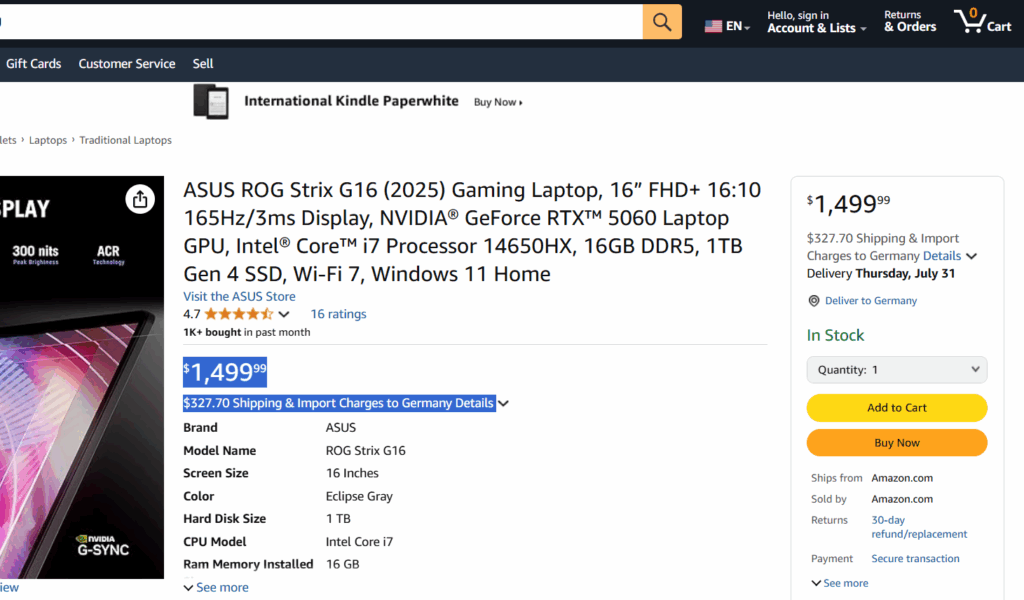
This is how price changes sales:
- $20 product with 15% conversion = 150 sales per 1000 visitors
- $35 product with 8% conversion = 80 sales per 1000 visitors
- $50 product with 3% conversion = 30 sales per 1000 visitors
More expensive items don’t sell as well, and Amazon thinks that people don’t want your products because of the low number of sales. So Amazon only shows it to a smaller group of people, which means even fewer sales.
What customers look at before buying:
| Factor | How It Affects Their Choice |
| Your price vs others | This matters most |
| What features do you offer | Can justify higher prices |
| How many reviews do you have | Makes them trust you |
| Your star rating | Shows if it’s good quality |
Most people choose the cheapest option that does what they need. As a result, if your product costs $40 but others charge $25 for similar things, you’ll lose most sales to them.
Pricing Strategies for Beer Amazon SEO
First, look at how much other people charge for products comparable to yours. Then, write down the prices of the top ten purchases in your group.
1- Find the Right Price
- Check prices of 10 similar products
- Add them up and divide by 10 to get the average
- Price yours within 10% of that number
- Go lower if you don’t have many reviews yet
If similar products cost $25, $30, $28, $35, and $32, that’s an average of $30. You should price yours between $27 and $33 to stay competitive.
2- Test Different Prices
- Week 1-2: Start with a competitive price ($28)
- Week 3-4: Try a slightly higher price ($32)
- Week 5-6: Go back to the original if sales dropped
Watch your sales each week, and if they drop more than 20%, go back to the lower price right away.
3- Change Your Price at the Right Time
- Lower it when you’re launching new products
- Raise it when you get 50+ good reviews
- Match when competitors drop their prices
- Check what others charge every week
Amazon Ads to Boost Your Amazon SEO Rankings
Sales from ads tell Amazon that people want what you’re selling. Amazon will then show your item to more people in natural search results if it thinks there is a lot of interest in it.
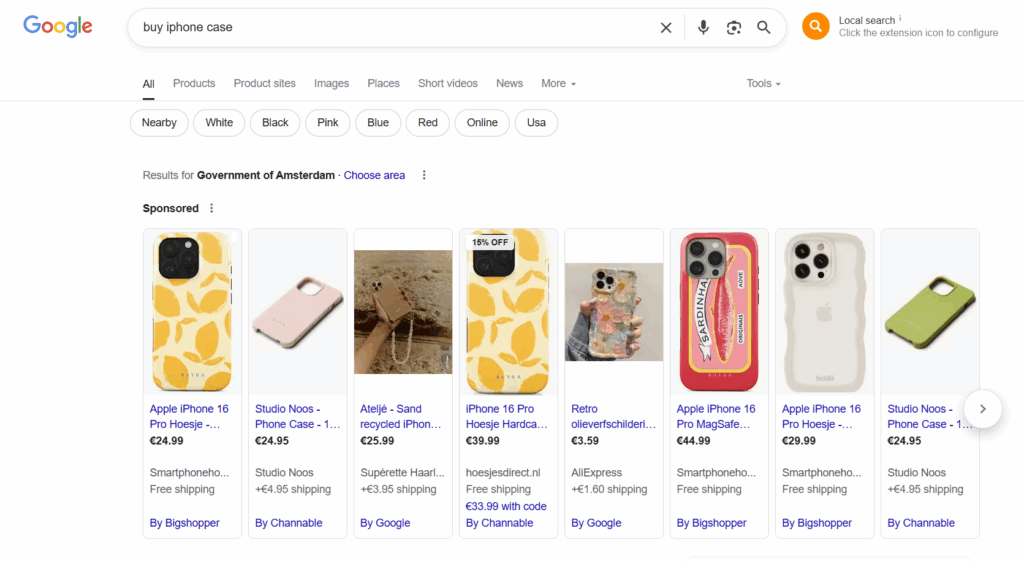
How do ads help Amazon’s SEO?
- Advertisements help you make sales quickly when you’re new.
- Your Best Seller Rank goes up when you sell more books.
- Higher ranks mean more free traffic.
- Higher sale rates help your Amazon SEO even more.
- Ad sales reviews help the success of your Amazon organic search
Which ad types work best for Amazon SEO?
Sponsored Products give you the best Amazon SEO boost because they target people searching for your exact keywords.
| Ad Type | SEO Benefit | Monthly Cost | Best For |
| Sponsored Products | High | $200-500 | New products |
| Sponsored Brands | Medium | $300-800 | Brand awareness |
| Sponsored Display | Low | $100-300 | Retargeting |
Budget split recommendation on Amazon ads:
- 70% on Sponsored Products ads
- 20% on listing optimization
- 10% on Sponsored Brands
Start with $10-15 per day for Sponsored Products and then increase when you see sales coming in consistently.
How to Make Ads That Help Your Amazon SEO?
Keep your attention on terms that fit with your Amazon SEO plan. Ads and page improvement should both use the same main terms.
1- Set up an Amazon Campaign
- Select the “Sponsored Products” type of marketing.
- Click on “Manual targeting” to take charge.
- Add your top 10 Amazon SEO terms that you found.
- Start bidding at $0.50 to $1.00.
- Run for at least 2 weeks.
2- Target Keyword for SEO Benefit
Use terms with a perfect match that people actually look for. If the term you want to rank for on Amazon is “Bluetooth speaker,” use that exact phrase in your ads.
Each plan should focus on 5–10 terms, so you shouldn’t spend too much on too many words.
Keep Track of What Works
Check these numbers once a week:
- Click-through rate (aim for 0.5% or higher)
- Conversion rate (aim for at least 10%)
- Cost of each sale (should be less than 30% of your cash flow)
- Organic ranking changes for your target keywords
When your ads do well, your natural rankings will generally get better in 3 to 4 weeks.
How Can Traffic From Other Websites Help Your Amazon SEO?
Other websites sending traffic to your products make Amazon think it’s popular everywhere.
So, you will do better in Amazon’s SEO if people click from Google or Facebook to buy what you’re selling.
Amazon gives you unique links that let it keep track of where your sales come from. You need to use these links in all of your ads so Amazon knows when people from outside their site buy something.
How to set it up?
- Go to your seller account and look for Amazon Attribution.
- Put tracking links on all of the places you promote.
- Only put these links in your outside ads.
- Always look over your reports once a week to see what’s working.
Top Places To Get Outside Traffic For Amazon SEO
| Traffic Source | Setup Time | Monthly Cost | How Many Buy | Works Best For |
| Facebook Ads | 2 hours | $200-500 | 8-12% | Everyday products |
| Google Ads | 3 hours | $300-800 | 10-15% | Products that solve problems |
| 1 hour | $100-300 | 6-10% | Pretty products | |
| Email lists | 4 hours | $50-150 | 15-25% | Customers who bought before |
| YouTube videos | 8 hours | $0-200 | 5-8% | Products you can demo |
What Numbers Should You Track For Your Amazon SEO?
Five main numbers show you how well your Amazon SEO performs. These metrics directly connect to your search rankings and sales performance.
| Metric | What It Shows | Where to Find It | Check How Often | Good/Bad Numbers |
| Keyword Rankings | Your position in search | Third-party tools | Weekly | Top 10 = Good, 50+ = Bad |
| Click-Through Rate | Clicks ÷ Views | Business Reports | Weekly | 0.5%+ = Good, under 0.2% = Bad |
| Conversion Rate | Sales ÷ Visits | Business Reports | Daily | 10%+ = Good, under 5% = Bad |
| Best Sellers Rank | Category position | Product page | Daily | Lower number = Better |
| Review Score | Average star rating | Product page | Daily | 4.0+ = Good, under 3.5 = Bad |
Where To Find Your Amazon SEO Metrics?
- Go to Seller Central and click “Business Reports“
- Check “Detail Page Sales and Traffic” for most metrics
- Look at your product page for BSR and review scores
Track these numbers every week because they change based on your Amazon SEO efforts and competitor actions.
How To Read Your Amazon SEO Metrics?
- Low click-through rate = your title or main image needs work
- Low conversion rate = your price, bullets, or photos need fixing
- Dropping keyword rankings = competitors are beating you
- Bad review scores hurt all your other Amazon SEO efforts
Free vs Paid Amazon SEO Tools That You Really Need
You don’t need expensive tools to start with Amazon SEO. Free tools work fine when you’re beginning, but paid tools save time as you grow.
Start free and upgrade when you can afford it.
Free Amazon SEO Tools
- Amazon autocomplete
- Seller Central reports: Log in to your seller account, click “Business Reports”
- Amazon Attribution: Find it in Seller Central under the “Advertising” tab
- Manage Your Experiments: Go to Seller Central, then “Brands” section
- Request a Review button: In Seller Central, go to “Orders” and click the button next to each order
These tools give you enough data to improve your listings and track your Amazon SEO progress.
Paid Amazon SEO Tools
Start out with free tools for the first 3 to 6 months. When you’re making at least $3,000 a month, you can buy paid tools because the time they save you will make up for their price.
| Tool Type | Free Option | Paid Option | Upgrade When | Monthly Cost |
| Keyword Research | Amazon search bar | Helium 10 | 10+ products | $30-100 |
| Rank Tracking | Manual checking | Sellics | Daily monitoring | $25-80 |
| PPC Management | Amazon interface | PPC software | $1000+ ad spend | $50-200 |
| Review Management | Manual replies | FeedbackWhiz | 50+ orders/month | $25-100 |
FAQs
Start with free tools like Amazon’s autocomplete and Seller Central reports. When you’re making consistent sales, upgrade to Helium 10 or Jungle Scout for better keyword research.
YouTube has free Amazon SEO courses that teach the basics. If you want detailed training, check out courses on Udemy or from Amazon agencies that cost around $200-500.
Type your product into Amazon’s search bar and write down all the suggestions that appear. Look at your top competitors’ titles and bullet points to see which keywords they use most often.
Amazon shows products that people actually buy, so it looks at your sales numbers and conversion rates. If customers click on your product and buy it often, Amazon will show your product to more people.
Yes, many companies hire Amazon SEO specialists to manage their product listings. These jobs pay $40,000-80,000 per year, and you can find them on LinkedIn, Indeed, or Upwork.
Track your keyword rankings, click-through rates, conversion rates, and sales numbers each week. Include which keywords are improving and which ones need more work so you know what to fix next.

